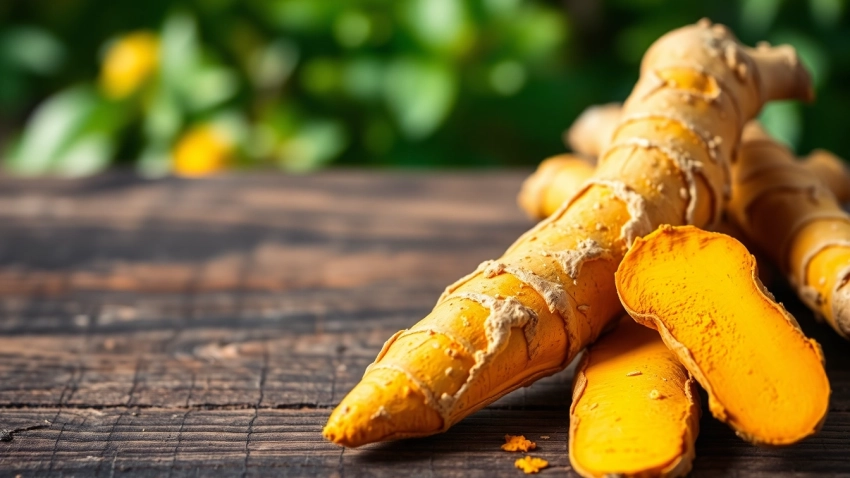
The Power of Turmeric Root: Health Benefits, Culinary Uses, and More
Understanding Turmeric Root
What is Turmeric Root?
Turmeric root, known scientifically as Curcuma longa, is a vibrant yellow-orange rhizome that belongs to the ginger family. This perennial plant has been cherished for centuries across various cultures, primarily for its culinary and medicinal properties. The edible part of the plant is its root, or rhizome, which is typically harvested, dried, and ground into a fine powder for use in cooking and natural remedies. With its earthy flavor and bright color, turmeric is a staple in many kitchens, predominantly in Indian cuisine, where it is a key ingredient in curries and other traditional dishes.
Not only is turmeric valued for its taste, but it also contains bioactive compounds known as curcuminoids, the most notable being curcumin. This compound is credited with many of the health benefits attributed to turmeric root, making it a subject of significant scientific research. For more information on the benefits and culinary uses of turmeric, you can explore Turmeric Root.
Origin and Cultivation of Turmeric Root
Turmeric is native to Southeast Asia, particularly India, where it has been cultivated for over 4,000 years. It thrives in tropical climates, requiring warm temperatures, high humidity, and well-drained soil. The cultivation of turmeric involves planting the rhizomes in the ground, where they grow into large plants with lush green foliage. Around 8-10 months after planting, the rhizomes are harvested, washed, and either used fresh or processed into powder.
India remains the world’s largest producer of turmeric, followed by countries such as Bangladesh, Taiwan, and Indonesia. The different regions contribute unique qualities to the turmeric produced, influenced by local soil conditions, climate, and agricultural practices. Thus, culinary and medicinal turmeric may vary in taste and potency depending on its geographic origin.
Distinguishing Features of Turmeric Root
Turmeric root is often confused with ginger due to its similar appearance. However, there are distinct features that set them apart. Turmeric has a deep orange-yellow inner flesh and a rough, brownish exterior. When freshly harvested, turmeric root has a vibrant, aromatic scent, which diminishes once it is dried and ground into powder.
When selecting turmeric roots for culinary use, freshness is critical. Fresh turmeric often carries a more pungent flavor and aroma compared to its dried counterpart. Additionally, fresh turmeric can be more versatile in cooking, lending a lively flavor to dishes that dried powder might not achieve.
Health Benefits of Turmeric Root
Anti-Inflammatory Properties
One of the most celebrated benefits of turmeric root is its potent anti-inflammatory properties. Curcumin, the primary active ingredient in turmeric, has been shown to reduce inflammation in the body by inhibiting various inflammatory pathways. This property is particularly beneficial for individuals suffering from chronic inflammatory conditions, such as arthritis and inflammatory bowel disease.
Numerous studies have explored curcumin’s efficacy in managing inflammation. For instance, research published in the Johns Hopkins Medicine has found that curcumin can induce a reduction in markers associated with inflammation, suggesting its potential as a natural anti-inflammatory agent.
Antioxidant Effects of Turmeric Root
Turmeric root is also renowned for its high antioxidant content. Antioxidants are substances that protect the body from oxidative stress, which can lead to cellular damage and increase the risk of chronic diseases, such as cancer and heart disease. Curcumin significantly elevates the antioxidant capacity of the body, counteracting free radicals and improving the overall antioxidant status.
Scientific evidence supports these claims, illustrating how turmeric supplementation can lead to a notable increase in the body’s ability to combat oxidative stress. A 2020 study highlighted curcumin’s role in enhancing antioxidant defenses in various demographic groups, indicating its protective benefits.
Potential Health Risks and Considerations
While turmeric root offers myriad health benefits, it is essential to exercise caution. Overconsumption of turmeric can lead to gastrointestinal issues, such as upset stomach, nausea, or diarrhea. Additionally, individuals with gallbladder problems or those on blood-thinning medications should consult with a healthcare provider before incorporating high doses of turmeric into their diets.
It’s also worth noting that the bioavailability of curcumin is relatively low, meaning that it may not be absorbed effectively by the body. Consuming turmeric with black pepper, which contains piperine, can enhance the absorption of curcumin and amplify its health benefits.
Culinary Applications of Turmeric Root
How to Use Fresh Turmeric Root in Cooking
Fresh turmeric root is highly versatile in culinary applications. It can be grated, minced, or sliced and added to various dishes, including soups, stews, stir-fries, and marinades. The earthy flavor of turmeric imparts a warm, slightly bitter taste that complements many foods.
For those looking to explore its culinary potential, fresh turmeric can be steeped in tea, blended into smoothies, or used as a delicious seasoning in rice dishes. It is also fantastic when included in homemade sauces and dressings. Incorporating fresh turmeric into meals is an excellent way to enjoy its health benefits while enhancing the dish’s flavor profile.
Popular Dishes Featuring Turmeric Root
Turmeric root is a central ingredient in many popular dishes. In Indian cuisine, it is commonly used in curries, dals (lentil dishes), and various rice preparations. Turmeric is also prevalent in Middle Eastern recipes, where it is often found in spice mixes like curry powder and harissa.
In addition to savory dishes, turmeric can be incorporated into sweet recipes. Unique offerings include turmeric-infused golden milk, a soothing drink made with milk and spices, and turmeric cakes or cookies that showcase its beautiful color and distinctive flavor. As culinary interests evolve, creative chefs continue to experiment with turmeric in various forms, pushing the boundaries of traditional cooking.
Tips for Storing and Preparing Turmeric Root
To maintain the freshness and potency of turmeric root, proper storage is essential. Fresh turmeric should be stored in a cool, dry place, preferably in a paper bag or wrapped in paper towels to absorb moisture. Refrigeration can prolong its shelf life; however, it should be used within a few weeks for optimal flavor.
When preparing turmeric root, it is advisable to wear gloves, as the vibrant yellow pigment can stain your hands and kitchen surfaces. A simple approach to using fresh turmeric is to peel the outer skin using a vegetable peeler and then use a microplane or grater to incorporate it into dishes. Its aromatic and flavorful properties will enhance any recipe it’s added to.
Turmeric Root in Traditional Medicine
Historical Uses of Turmeric Root in Ayurveda
Turmeric root has a rich history in traditional medicine, especially within Ayurvedic practices. In Ayurveda, turmeric is considered a “super spice,” revered for its balance of three doshas: Vata, Pitta, and Kapha. It is often used to support digestive health, boost the immune system, and enhance skin health.
Ayurvedic practitioners utilize turmeric in various forms, including pastes, teas, and tinctures, to treat ailments ranging from skin disorders to digestive issues. Its warming properties are thought to promote circulation and relieve colds and flu symptoms, establishing turmeric as a foundational herb in holistic health.
Modern Herbal Remedies Involving Turmeric Root
In contemporary herbal practices, turmeric continues to be valued for its therapeutic potential. Its incorporation into supplements, herbal blends, and essential oils reflects its growing popularity as a natural remedy. Many people consume turmeric in capsule form, while others prefer tinctures, teas, or powders to integrate the herb into their daily diets.
Herbalists may recommend turmeric for various health issues, including arthritis, skin conditions, and digestive health. Moreover, its anti-inflammatory and antioxidant properties have prompted many researchers to explore its role in preventing chronic diseases, such as cardiovascular diseases and neurodegenerative conditions.
Scientific Research on Turmeric Root Benefits
The last few decades have witnessed a surge in scientific interest surrounding turmeric root and its myriad benefits. Numerous studies have investigated its effects on inflammation, oxidative stress, and various chronic diseases. Meta-analyses have concluded that curcumin has the potential to significantly impact health outcomes, especially when used in conjunction with other treatments.
Furthermore, the growing body of evidence is steadily supporting the traditional uses of turmeric root. Research published in reputable journals indicates that curcumin may aid in managing conditions such as osteoarthritis, inflammatory bowel disease, and even certain types of cancer. The ongoing exploration of turmeric in clinical settings will likely reveal even more benefits and applications in the future.
Where to Buy Turmeric Root
Finding Quality Turmeric Root Products
When looking to purchase turmeric root, it is essential to consider the quality and source of the products. Fresh turmeric is typically available in well-stocked grocery stores, particularly those specializing in organic or international foods. For dried turmeric root powder, health food stores and online retailers often provide a wide selection of organic and non-organic options.
Additionally, looking for reputable brands that offer transparency in sourcing can ensure that the turmeric you purchase is of high quality, free from contaminants, and properly stored. Many organic brands prioritize sustainable practices, contributing positively to both health and environmental well-being.
Comparing Prices and Sources for Turmeric Root
Pricing for turmeric root can vary significantly depending on the form and quality of the product. Fresh turmeric root typically costs more per pound than dried powder due to its limited shelf life and higher spoilage rates. Organic turmeric may also come at a premium compared to its conventional counterparts, but many consumers find the additional health benefits worth the investment.
When considering where to buy turmeric, it is helpful to compare both local options and online bargains. Many retailers offer bulk purchasing options for greater savings, especially for those who frequently use turmeric in cooking or supplements.
Factors to Consider When Buying Turmeric Root
When purchasing turmeric root, a few critical factors should be taken into account:
- Form: Determine whether you want fresh, dried, or powdered turmeric based on your intended use.
- Quality: Seek organic or sustainably sourced turmeric to maximize health benefits and minimize exposure to pesticides.
- Freshness: For fresh turmeric, check for firmness and vibrant color. For powdered turmeric, confirm the packaging date to ensure potency.
- Reputation of the Supplier: Opt for recognized brands or local vendors with a solid reputation for quality products.
By considering these factors, you can make informed decisions while purchasing turmeric root products that align with your culinary and health objectives.












Leave a Reply